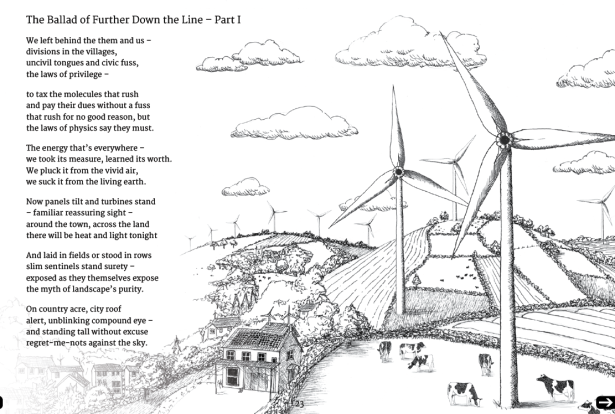This post comes from the Artists and Climate Change Blog
For #NationalPoetryMonth, Joan Sullivan interviews UK poet Matt Harvey. This is the fourth installment of Renewable Energy Artworks, a monthly series on Artists & Climate Change.
Matt Harvey has written a lovely little book of poetry inspired by renewable energy. Published in 2014, The Element in the Room is dedicated to “all those unsung souls quietly doing what they can to bring renewable energy to their communities.â€

Short-and-sweet, the book is deceptively whimsical. Harvey opens his book with apologies to Dr. Seuss:
Energy cannot die – it’s just redeployed
it can’t be created, it can’t be destroyed
it can’t be frustrated, it won’t get annoyed
it can’t be upset, it can’t get in a mood
but it can be renewed and renewed and renewed
Featuring 32 poems – some several pages long, others as short as two lines – the book contains a variety of poetic styles, including a sonnet, a country and western song, and a prose poem cleverly entitled The Not-For-Prophit, as in:
“I didn’t say it would be easy.
A set charge per tonne of carbon emissions
would do more to save the planet
than any amount of recycling
and green poetry anthologies.â€
Harvey also includes three “crowd-sourced†poems in his book. These are poems created through a process that Harvey calls “decimal democracy†in which the poet challenges his audiences to vote on a theme and then collectively contribute individual lines that are later taped together into a coherent (or not!) ensemble. As an example, here are a several lines from the crowd-sourced ode Turbines Are Beautiful:
Friendly sentry standing on a hillside giving us power
Bladed beauties, air cleavers
Daddy! Look, a windy bine!
What, no cooling towers?
The book also contains an important foreword by Jonathon Porritt, Founding Director of the Forum for the Future and author of The World We Made, a book we reviewed on Artists & Climate Change in 2014.
Readers of the Artists & Climate Change blog will recognize the prescience of Mr. Porritt’s words:
“Through time, poets and artists of all kinds have held a mirror up to society, to help us reflect and engage with some of the fundamental questions we face. Energy cannot be considered from an entirely intellectual perspective; energy generation is the unrecognized beating heart of our culture, the invisible ingredient in our diets, the unseen web that binds us to each other, to our places of work and our places of fun, and to strange people in strange lands. We cannot hope to grasp the magnificent complexity of this without art (emphasis added).â€
With solar panels on his own roof, Harvey clearly is a fan of renewable energy: “I’ve always liked the look of wind turbines.† But he does not shy away from controversial topics, notably NIMBYism (An Unchanging View) and consumerism (Less is More). He devotes no less than six poems to explore resistance to wind development, and why wind turbines seem to be “loved by many and loathed by some.â€
If I had to choose my favorite tongue-in-cheek line in the book, it would have to be this:
“Don’t look a gift source in the mouth”
Let me end this post with Harvey’s playful paean to solar energy:
A Radiant Romance
To fly so far, so fast
And land so gentlyUpon a panel on planet Earth
Eight and a third minutes old
And worth its weightlessness in goldFallen, faded and cooled
Then to be told,
‘Oi photon. Get your coat on.
You’ve been pulled.’
About Artists and Climate Change:
Artists and Climate Change is a blog that tracks artistic responses from all disciplines to the problem of climate change. It is both a study about what is being done, and a resource for anyone interested in the subject. Art has the power to reframe the conversation about our environmental crisis so it is inclusive, constructive, and conducive to action. Art can, and should, shape our values and behavior so we are better equipped to face the formidable challenge in front of us.


